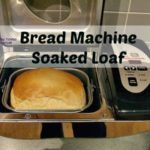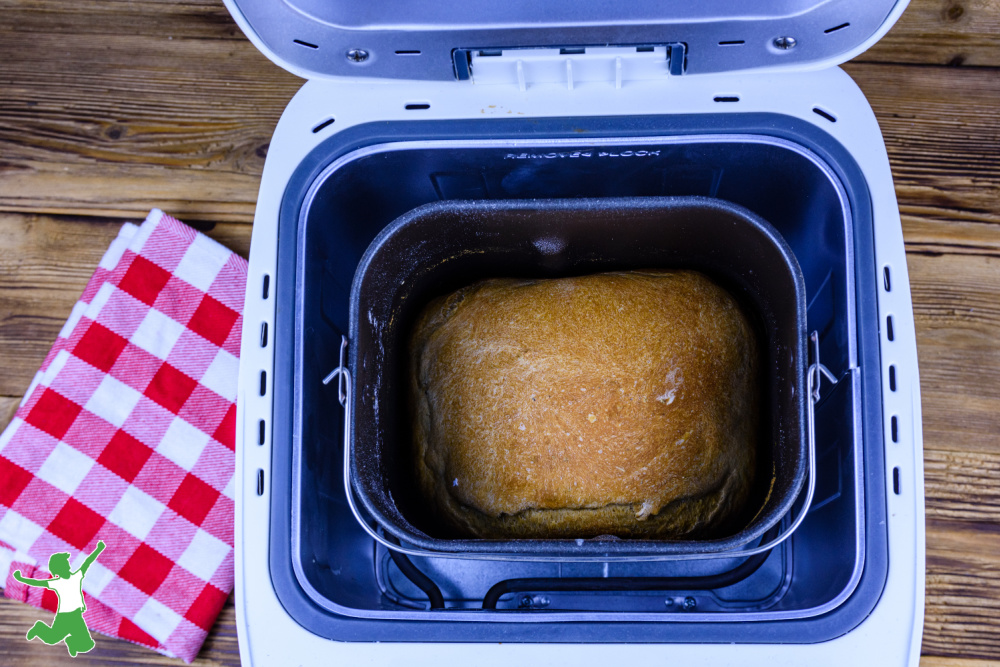Table of Contents[Hide][Show]
A handy bread machine recipe for a delicious, conveniently made loaf using soaked flour for much improved nutrition and digestibility.
Homemade bread is making a comeback! The convenience of using a bread machine recipe is part of the reason why as more and more people opt to make their own with quality ingredients they source themselves.
Quality over convenience is an idea whose time has come in the bread department. The general public is awakening to the dangers of white flour, one of the “displacing foods of modern commerce” as described by Dr. Weston A. Price in his nutritional classic Nutrition and Physical Degeneration.
This is a radical change from even just a few decades ago.
My Grandmother, like many of her generation, always chose white bread over “brown bread” as she called it. She considered whole wheat bread a sign of poverty because she observed growing up that those who ate white bread were more affluent and educated.
Fortunately, this notion is no longer a popular mindset.
Whole Grain Homemade Bread is Best
Not only is bread made with white flour basically devoid of nutrition, but it also adds to the body’s toxic load with a plethora of additives, chemicals, and unhealthy vegetable oils.
Worse, unlike the white bread even just 10 years ago, store bread frequently contains soy flour. This modern food threatens hormonal health and can trigger digestive problems for those who are sensitive.
Even commercially made sprouted bread masquerading as healthy frequently contains seitan or vital wheat gluten. This additive is nearly impossible to digest when isolated for use by food manufacturers.
Consumers choosing to bake their own bread usually forgo white flour in favor of whole wheat or other whole grains. Popular examples include teff or millet.
While whole grain flour may be fresher when you grind it at home and the bread more nutritious, other problems can emerge.
Modern breadmaking using a bread machine recipe typically employs the use of yeast and high heat. This quickly raises the dough and bakes the bread in a short amount of time.
This contrasts with the slow, natural rise that occurs with fermented dough baked at a lower temperature.
Why Use Soaked Flour?
Science has demonstrated the wisdom of the careful preparation methods of our ancestors. All grains and legumes contain phytic acid, an organic acid that blocks mineral absorption in the intestinal tract.
Powerful anti-nutrients in grain flour are neutralized in as little as 7 hours of soaking in water with small amounts of an acidic medium.
Examples include yogurt, kefir, lemon juice or cider vinegar. Soaking also neutralizes enzyme inhibitors present in the hulls of all grains and adds beneficial enzymes that increase the amount of nutrients present – especially the B vitamins.
For those with gluten intolerance, soaking or fermenting gluten-based grains breaks down this difficult-to-digest plant protein; studies carried out in Italy have found that people with celiac disease can consume genuine sourdough bread without digestive distress or auto-immune symptoms.
I frequently get asked how to make fresh bread at home using the traditional method of soaking flour first combined with the modern convenience of a bread machine.
If you have a breadmaker and would like to transition to a traditional method for making bread while continuing to use this appliance, here’s a bread machine recipe to try.
It is adapted from Healthy4Life by the Weston A. Price Foundation.
Enjoy your fresh-baked loaf courtesy of a blend of modern convenience and Traditional Wisdom!

Bread Machine Recipe using Soaked Flour
A handy bread machine recipe for a delicious conveniently made loaf using the traditional preparation method of soaking flour for much-improved nutrition and digestibility.
Ingredients
- 10 Tbl whole yogurt
- 3/4 cup filtered water
- 4 cups whole grain flour less 3 Tbl, preferably freshly ground
- 2 Tbl butter softened
- 1 Tbl molasses
- 3 Tbl arrowroot powder
- 1 3/4 tsp dried yeast
- 1 tsp sea salt
Instructions
-
Mix yogurt with water and mix with the flour to form a dough. Cover and leave in a warm spot on the kitchen counter for 18-24 hours.
-
When it is partway through the kneading section, check that all the ingredients have mixed together and observe the consistency of the dough.
-
If it is slimy, add some more arrowroot powder. If it’s too dry, add a few more drops of water, drop by drop.
-
Proceed as directed for your particular bread machine model to finish baking your traditional loaf!
Once you’ve made your soaked loaf, be sure to save the crusts because they are perfect for making breadcrumbs!
More Traditional Bread Recipes
Interested in traditional breadmaking? Try these other recipes inspired by ancestral wisdom.









Is this bread supposed to taste sour? Mine came out very sour, much more than sourdough would.
It was also so wet. I added 6 extra tablespoons of arrowroot because the dough was sticky per instructions. Apparently they wasn’t enough because it completely flattened out during the rise and the finished product collapsed down on itself. I milled the spelt myself.
Yes, it is supposed to taste slightly sour.
Thanks! I actually prefer not to soak my grains because I don’t want to miss the many benefits of phytic acid, which in my mind, outweigh a small amount of mineral binding. I get plenty of minerals in the rest of my diet. BUT…I can’t eat modern wheat, soaked, sprouted of whatever. Enter einkorn flour. Real wheat, but with teensy percentage of gluten as compared to modern wheat. Obviously, it also doesn’t bake the same, especially in bread. Soaking helps, but I’ve only been wetting the bottom half of the flour pile because of the bread machine imperative not to let the yeast tough the liquid…but clearly it can work. So thank you! I’ll soak it all now.
Whole meal setting: I’m new to bread making by machine. In this recipe (soaked flour) what setting would be equivalent to “whole meal”? I have whole wheat, whole wheat rapid, gluten free, and bake only options on my machine. I’m using spelt flour.
Use the whole wheat setting.
Could you sub tapioca for the arrowroot?
I haven’t tried it, so don’t know. Let us know how it turns out if you do this substitution.
AHHH
I made this bread and it was pretty good. I made the mistake of using Greek yogurt. I had to add some water. That and make some adjustments in the other ingredients. I use my bread machine mainly for the mixing and the first rise as I don’t like messing with the paddle. Since I take my bread out of the machine, why can’t I just put it in the fridge for a day instead of soaking the first ingredients? Does the yeast interact with the wheat to prevent the breakdown of the anti nutrients? I haven’t got the patience to make sourdough. Also if I take an organic whole grain cereal and soak it overnight, would that make a difference in the nutritional content. I appreciate your fast answer to my last question.
The cold of the refrigerator hinders the breakdown of the anti-nutrients from the beneficial microbes in the soaking medium.
What does the arrowroot powder do for this recipe?
It helps give the dough the proper consistency.
Hi! Did you ever figure it out? We moved to Oahu a couple of years ago and have been making our own bread with a natural yeast start. However, it’s SO HOT during the summer that I hate baking in the oven! I would love to know if you figured out this method– so I can keep the heat contained to the bread maker! 🙂